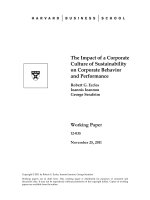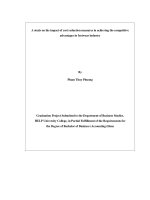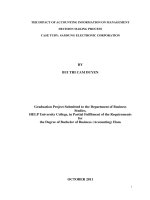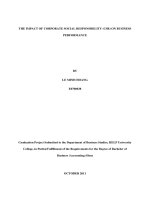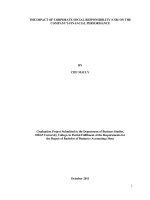The impact of supply chain practices on performance through supply chain integration in textile and garment industry of Vietnam
Bạn đang xem bản rút gọn của tài liệu. Xem và tải ngay bản đầy đủ của tài liệu tại đây (1.25 MB, 12 trang )
Uncertain Supply Chain Management 8 (2020) 175–186
Contents lists available at GrowingScience
Uncertain Supply Chain Management
homepage: www.GrowingScience.com/uscm
The impact of supply chain practices on performance through supply chain integration
in textile and garment industry of Vietnam
Thi Thu Hien Phana*, Xuan Toan Doanb and Thi Thanh Tam Nguyenc
a
University of Economic and Technical Industries, Vietnam
University of Kinh Bac, Vietnam
c
Academy of politics region I, Vietnam
b
CHRONICLE
Article history:
Received June 17, 2019
Received in revised format June
28, 2019
Accepted July 17 2019
Available online
July 17 2019
Keywords:
Supply chain practices
Performance, supply chain
integration
Textile and garment industry
Vietnam
ABSTRACT
This paper is intended to evaluate intermediary role of SCI in the relationship between supply
chain management practices (SCMP) and supply chain performance (SCP) and, at the same
time, to examine the regulatory role of firm size and transformational leadership in this
relationship. The research is conducted on 536 Vietnamese textile and garment enterprises and
the results show that SCI had a complete intermediary role in the relationship between SCMP
and SCP. Additionally, Size and Transformational leadership also play statistically significant
regulatory role in the relationships between SCMP and SCI as well as between SCMP and
SCP. Accordingly, it is recommended that enterprises should implement SCMP well to
improve the effectiveness of SCI and SCMP, contributing to sustainable development and
ensuring requirements of global supply chains.
© 2020 by the authors; licensee Growing Science, Canada .
1. Introduction
Currently, Vietnam is increasingly integrating comprehensively with countries in the region and around
the world. During the two years of 2018 and 2019 alone, there have been many trade agreements entered
into such as CPTPP, EVFTA, etc., which have created many opportunities as well as challenges for
Vietnam when being part of the world market and global supply chains. Especially for the textile and
garment industry, this is a key industry of Vietnam with the second highest export turnover in the
country, creating job for 1/5 of the total labor force of Vietnam.
However, the survey results of the research group show that most of Vietnamese textile and garment
enterprises still operate under small scale and tattered production, not complying with the standards on
working conditions and origin of materials. In addition, in the context of the US-China trade tensions
if Vietnam does not strictly manage the input materials to ensure the origin of goods, it will be subject
to very high import and export tax rates, which will affect operational efficiency of enterprises.
Therefore, activities of supply chain management play a very important role. In spite of that, in the
context of Vietnam - a developing country, the research on this topic is still very limited, especially in
Vietnam’s textile and garment industry.
* Corresponding author
E-mail address: (T.T. H. Phan)
© 2020 by the authors; licensee Growing Science.
doi: 10.5267/j.uscm.2019.7.006
176
Research on supply chain management is an area to which many researchers around the world have
paid attention as these activities can create competitive advantages and improve operational efficiency
for enterprises (Azadi et al., 2014; Sabara et al., 2019). Thanks to supply chain management, enterprises
can connect with each other, improve conflicts and create a unified playing field for their mutual
interests (Zhang et al., 2015).
In previous studies, the relationship between supply chain management practices (SCMP) and supply
chain performance (SCP) has been studied a lot, however, there is a lack of evidence for the complex
relationship between SCMP and SCP. Particularly, the research examining SCI’s intermediary role is
still too limited. Previous studies have examined the relationship between SCMP and firm performance
only (Veera et al., 2011), or tested the relationship between supply chain integration (SCI) and firm
performance (Zolait et al., 2010) without referring to the link between SCMP and SCP through SCI.
Notably, almost no author has examined the regulatory role in the relationships between SCMP, SCI
and SCP.
To fill those theoretical and practical gaps, this paper aims to examine SCI’s intermediary role in the
relationship between SCMP and SCP at first. Secondly, it tests the regulatory role of Size and
Transformational leadership in the relationship between SCMP and SCI as well as between SCMP and
SCP. In addition to the introduction, the paper includes the following parts: Overview and research
hypothesis, Research methodology, Research results and Conclusion.
2. Literature Review and research hypotheses
The research is to evaluate SCI’s intermediary role in the relationship between SCMP and SCP.
Previous studies have shown that SCI has a partial intermediary role in the relationship between SCMP
and SCP when surveying 156 electronics companies in Malaysia in the studies by Sundram et al.
(2015), Naway and Rahmat (2019). Enterprises implement a set of supply chain management activities
to promote collaboration between internal departments and cooperate with other companies from
suppliers to customers in the supply chain (Pramatari, 2007). Previous studies have begun to doubt that
the relationship between SCMP and SCP is an intermediate relationship, not a direct relationship, which
depends on the ability to integrate components and organizations across the supply chain through SCI.
Therefore, we propose the below hypotheses:
H1: SCI plays a complete intermediary role in the relationship between SCMP and SCP.
H2: Size plays a regulatory role in the relationship between SCMP and SCI.
H3: Transformational leadership plays a regulatory role in the relationship between SCMP and SCP.
Supply chain integration (SCI): This factor determines the level of integration, integrating supply chain
activities between enterprises, suppliers and customers (Flynn et al. 2010). The role of SCI is to mediate
between enterprises and customers and suppliers based on production process characteristics and
headquarters of enterprises (Naslund & Hulthen, 2012; Setyadi, 2019; Wadhwa et al., 2006). Activities
in SCI include: integrating departments and units within enterprises such as transport unit, material
purchasing unit and production unit; At the external level, SCI will integrate activities between
suppliers and customers in delivery and data flow connection from suppliers to enterprises and their
customers (Schoenherra & Swink, 2012). In order to measure SCI, we use four development scales
from study of Sezen (2008) and measured by a 5-point Likert scale with a score of 1 indicating “strongly
disagree” and 5 representing “strongly agree”.
Supply chain performance (SCP): Supply chain performance is an important part contributing to firm
performance. Previously, in order to evaluate firm performance, most researchers often use financial
efficiency (Hasan et al., 2018). However, in this paper, we aim to evaluate how supply chain
management practices impact supply chain performance or efficiency, a small part of firm performance.
Moreover, SCP is typically a continuous process in the supply chain and thus the biggest challenge
when measuring SCP is to ensure the true performance of the entire supply chain. For that reason, we
T.T. H. Phan et al. /Uncertain Supply Chain Management 8 (2020)
177
measure SCP based on development of the research by Sundram et al. (2015). Measured by 5-point
Likert scale as a unit of measurement ranging from “definitely worse” to “definitely better” in relation
to their major competitors.
Supply chain management practices (SCMP): Activities or policies of enterprises to manage their
supply chains. According to Sandhu et al. (2013), supply chain management activities are established
from 7 aspects: Supplier strategic partnership, Information sharing, Information quality, Customer
relationship, Agreed vision and goals, Risk and reward sharing and postponement. In this paper, we
develop 7 aspects of SCMP measurement developed from the research by Min & Mentzer (2004) and
Sundram et al. (2015). Measured by 5-point Likert scale with a score of 1 indicating “strongly disagree”
and 5 representing “strongly agree”.
Transformation leadership: This is the leadership style of manager towards the stakeholders’ interests.
In order to measure Transformation leadership, we have built 4 items developed from the research by
Waldman et al. (2006). Measured by 5-point Likert scale with a score of 1 indicating “strongly
disagree” and 5 representing “strongly agree”.
Size: This item is also beasured by 5 levels in line with levels of enterprises division of the State of
Vietnam in accordance with Circular No. 39/2018/TT-BTC.
3. Research methodology
3.1. Research sample
Research sample is Vietnamese textile and garment enterprises in “Vietnamese Textile and Garment
Directory, 2018”. On Vietnam’s development path, its textile and garment enterprises play a very
important role. These enterprises mainly export their products to world markets such as Europe,
America and Japan. The export turnover in 2018 of Vietnamese textile and garment enterprises reached
over 36 billion USD, contributing about 20% of the national growth domestic products (GDP) and
creating jobs for more than 3 million workers nationwide.
Our research sample includes Vietnamese textile and garment enterprises which are members of
Vietnam Textile and Apparel Association and Vietnam Cotton and Spinning Association. We designed
the questionnaire after interviewing experts and actual qualitative research at Vietnamese textile and
garment enterprises across North, Central and South. Survey forms were sent directly to the members
of Vietnam Textile and Apparel Association and Vietnam Cotton and Spinning Association through
workshop materials and soft copy via email. After 3 months with the efforts made by the research team
together with the help from Vietnam Textile and Apparel Association and Vietnam Cotton and
Spinning Association, we have collected more than 600 surveys, which is a very encouraging number.
However, after classification and inspection, only 536 valid questionnaires are eligible for data analysis.
3.2. Analysis techniques
In order to analyze the data, thereby achieving the goal of the research team, we used two popular
analytical soft wares including SPSS 22 and Smart PLS 3.0. For SPSS 22, we entered data and checked
basic information on the scale of the potential variable. Specifically, we tested the reliability of the
scale through Cronbach Alpha and total correlation coefficients. With scales of Cronbach Alpha
coefficient <0.7 and the total correlation coefficient <0.4, they were removed from the research model
(Hair et al., 2006). Next we conducted exploratory factor analysis for potential variables: Supply Chain
Integration (SCI); Supply Chain Integration (SCI); Supply Chain Performance (SCP). Particularly, the
variable of Supply chain management practices (SCMP) is a formative construct and the 2 nd- order
factor, thus it is not suitable for EFA analysis (Hair et al., 2010, 2014). To examine intermediary role
and regulatory role, we used bootstrap technique with a sample estimate of 1000 on the software of
Smart PLS 3.0.
178
3.3. Research model
Supplier Strategic
Partnership (SSP)
Customer
Relationship
Supply
Chain
Integration
(SCI)
Information
Sharing (IS)
Information
Quality (IQ)
Supply chain
management
practices
Supply Chain
Performance
(SCP)
(SCMP)
Postponement
(POS)
Agreed Vision and
Goals (VIGOL)
Risk and Reward
Sharing (RR)
Transformation
Leadership
Fig. 1. Research model
Research variables in the model were developed from the review of previous studies, then we developed
and revised based on the qualitative research results to suit the context and culture of Vietnam.
4. Research results
Firstly, we tested scale reliability and the results showed that all scales of variables met the conditions
for the next analysis except the scales of SCMP4, SCMP7, SCMP13, SCMP17, SCMP 24 and SCMP27
with Cronbach Alpha <0.6 and thus they were removed before included in the analysis. Like this, SCMP
variable had 26 items left qualified for analysis. EFA analysis results show that the independent
variables separated into 3 separate variables except the formative construct variable of SCMP. Then,
with data tested for reliability, we entered into Smart PLS 3.0 to examine research hypotheses. The
results of general reliability test and Discriminant Validity are given in Tables (1-2), respectively.
Table 1
Construct Reliability and Validity
Agreed Vision and Goals (VIGOL)
Customer Relationship (CR)
Information Quality (IQ)
Information Sharing (IS)
Postponement (POS)
Risk and Reward Sharing (RR)
Supplier Strategic Partnership (SSP)
Supply Chain Integration (SCI)
Supply Chain Performance (SCP)
Supply chain management practices (SCMP)
Cronbach's Alpha
0.872
0.910
0.911
0.928
0.898
0.872
0.871
0.920
0.949
0.982
rho_A
0.872
0.911
0.911
0.928
0.898
0.872
0.875
0.920
0.952
0.983
Composite Reliability
0.872
0.910
0.911
0.928
0.898
0.872
0.871
0.920
0.948
0.982
Average Variance Extracted (AVE)
0.694
0.629
0.672
0.682
0.638
0.695
0.575
0.697
0.650
0.666
T.T. H. Phan et al. /Uncertain Supply Chain Management 8 (2020)
179
Table 2
Discriminant Validity Fornell-Larcker Criterion
Agreed Vision
and Goals
(VIGOL)
Agreed Vision and
Goals (VIGOL)
Customer
Relationship (CR)
Information
Quality (IQ)
Information
Sharing (IS)
Postponement
(POS)
Risk and Reward
Sharing (RR)
Supplier Strategic
Partnership (SSP)
Supply Chain
Integration (SCI)
Supply Chain
Performance
(SCP)
Supply chain
management
practices (SCMP)
Customer
Relationshi
p (CR)
Informati
on Quality
(IQ)
Informati
on
Sharing
(IS)
Postpon
ement
(POS)
Risk and
Reward
Sharing
(RR)
Supplier
Strategic
Partnership
(SSP)
Supply
Chain
Integration
(SCI)
Supply Chain
Performance
(SCP)
Supply chain
management
practices (SCMP)
0.833
0.037
0.793
0.067
0.020
0.820
0.194
0.030
0.088
0.826
0.022
0.049
0.010
0.026
0.799
0.037
0.193
0.089
0.332
0.282
0.833
0.314
0.123
0.125
0.223
0.164
0.391
0.758
0.231
0.274
0.250
0.261
0.170
0.296
0.121
0.835
0.391
0.394
0.394
0.397
0.132
0.363
0.077
0.214
0.806
0.011
0.040
0.014
0.015
0.036
0.185
0.126
0.263
0.398
0.816
180
All variables are satisfied, moreover, VIF results show that all values are >5. Therefore, the variables
are not multi-collinear. We then examine relevance of the research data and the research model .
Table 3
Model fit
Saturated Model
0.056
3.127
3.128
4,532.81
0.889
SRMR
d_ULS
d_G
Chi-Square
NFI
Estimated Model
0.068
5.620
3.156
4,816.36
0.901
The results show that the research data is relevant to the research model. From this, we examine the
research hypothesis with Smart PLS 3.0.
To examine hypothesis H1 according to Hair et al. (2014), we must go through 4 steps: Step 1: having
direct and statistically significant impact between SCMP and SCP. Step 2: having direct and
statistically significant impact between SCMP and SCI.
Step 1: having direct and statistically significant relationship between SCMP and SCP
(a)
(b)
Fig. 2. a: direct relationship between SCMP and SCP
b: Results of testing the direct relationship between SCMP and SCP
It can be seen from results in Fig. 2b that SCMP has a very strong direct impact on SCP at the impact
level of 0.387 and at the significance level of 1% (P-value = 0.000). This means satisfying the
conditions to test SCI’s intermediary role in the relationship between SCMP and SCP. However, SSP
aspect of SCMP variable does not satisfy the weight condition constituting SCMP variable.
Step 2: Having direct and statistically significant relationship between SCMP and SCI
T.T. H. Phan et al. /Uncertain Supply Chain Management 8 (2020)
181
Fig. 3. Results of examining the direct impact of SCMP on SCI
We can see from results in Fig. 3 that SCMP has a very strong impact on SCI with the impact level of
0.442 and the significance level of 1% (P-value = 0.000). Like so, it is qualified to test step 3. However,
SSP aspect of SCMP variable does not satisfy the weight condition constituting SCMP variable.
Step 3: Having direct and statistically significant impact between SCMP and SCP
Fig. 4. Direct impact of SCI and SCP
Results in Fig. 4 show that SCI has a very strong and statistically significant impact on SCP with the
impact level of 0.483 and the significance level of 1% (P-value = 0.000). Briefly, all the first three steps
are satisfied. Finally, we examine SCI’s intermediary role as follows:
Step 4: Examining SCI’s intermediary role in the relationship between SCMP and SCP
182
Fig. 5. Model to be examined intermediary role
Fig. 6. Results of intermediary role examination
(Bootstrap out)
It can be seen from results of bootstrap test in Fig. 6 that in the overall SEM model, SCMP no longer
has statistically significant impact on SCP. Therefore, according to Hair et al. (2017), SCI has a
complete intermediary role in the relationship between SCMP and SCP. This means that H1 hypothesis
is supported. This result is consistent with the research by Sundram et al. (2015) and Mira et al. (2019).
Hypothesis test results are as follows:
Table 4
Hypothesis test results
Agreed Vision and Goals (VIGOL) → Supply chain
management practices (SCMP)
Customer Relationship (CR) → Supply chain management
practices (SCMP)
Information Quality (IQ) → Supply chain management
practices (SCMP)
Information Sharing (IS) → Supply chain management
practices (SCMP)
Postponement (POS) → Supply chain management practices
(SCMP)
Risk and Reward Sharing (RR) → Supply chain
management practices (SCMP)
Supplier Strategic Partnership (SSP) → Supply chain
management practices (SCMP)
Supply Chain Integration (SCI) → Supply Chain
Performance (SCP)
Supply chain management practices (SCMP) → Supply
Chain Integration (SCI)
Supply chain management practices (SCMP) → Supply
Chain Performance (SCP)
Original
Sample (O)
Sample
Mean (M)
Standard Deviation
(STDEV)
T Statistics
(|O/STDEV|)
Sig.
0.114
0.114
0.007
15.994
0.000
0.214
0.213
0.005
46.811
0.000
0.187
0.186
0.004
42.533
0.000
0.225
0.226
0.007
32.898
0.000
0.184
0.185
0.005
40.435
0.000
0.116
0.116
0.004
27.232
0.000
0.001
0.001
0.001
1.020
0.308
0.387
0.389
0.055
7.015
0.000
0.441
0.445
0.041
0.814
0.500
0.214
0.214
0.060
3.584
0.000
Results reveal that in the overall SEM model, SCMP no longer has statistically significant impact on
SCP as in Fig. 6. As a result, H1 hypothesis is accepted. Next we examine the regulatory role of
regulatory variables.
T.T. H. Phan et al. /Uncertain Supply Chain Management 8 (2020)
183
Fig. 7. Model to be examined regulatory role
Results of regulatory role examination of Firm size and Transformation leadership are shown in Fig. 8.
It can be seen from results of regulatory role examination in Figure 8 that both size and transformational
leadership have a statistically significant regulatory role. This means that the larger the enterprises are,
the stronger the SCMP will impact SCI activities, whereas the smaller the enterprises are, the weaker
SCMP will impact SCI. At the same time, for enterprises with the more the leaders support
transformational leadership, the more SCMP activities will have a strong impact on SCP and vice versa,
for enterprises with leaders less supportive of transformational leadership, the impact of SCMP on SCP
is still in the same direction but weaker.
184
Fig. 8. Results of regulatory role examination of size and Transformational leadership
Results of regulatory role examination are modeled as follows:
(a)
(b)
Fig. 9. Regulatory role of size and transformational leadership
T.T. H. Phan et al. /Uncertain Supply Chain Management 8 (2020)
185
5. Conclusion
The paper has presented the positive impacts of SCMP with 6 statistically significant aspects on SCI
and SCP, unlike previous studies such as those by Sundram et al. (2015) that all 7 aspects were
statistically significant. In the context of Vietnam, especially for garment and textile enterprises, SCI
plays a complete intermediary role in the relationship between SCMP and SCP. Data collected from
536 Vietnamese textile and garment enterprises show that supply chain management activities had a
strong impact on operational efficiency, especially the efficiency of supply chains. Moreover,
Vietnamese textile and garment enterprises mainly operate in the form of order processing, together
with the fact that Vietnam has participated in many regional and international trade agreements,
therefore, supply chain management plays a very important part to meet requirements on origin of
goods and create opportunity to enjoy tariff benefits. Likewise, the research has also revealed that size
and transformational leadership had a statistically significant regulatory role in the relationships
between SCMP and SCI as well as between SCMP and SCP. This results are consistent with the
research of Naway and Rahmat (2019). Vietnamese textile and garment enterprises should attach
special importance to SCMP activities towards SCI and SCP as recommended in the research by Daehy
et al. (2019). In conclusion, to realize the desire to participate in the world market and become part of
the global supply chain in textile and garment industry, Vietnamese textile and garment enterprises
must perform SCMP activities towards SCI to improve efficiency of SCP for enterprises and step by
step improve operational efficiency towards sustainable development.
References
Azadi, M., Saen, R.F. & Zoroufchi, K.H. (2014). Anew goal-directed benchmarking for supplier
selection in the presence of undesirable outputs. Benchmarking: An International Journal, 21(3),
314-328.
Daehy, Y., Krishnan, K., Alsaadi, A., & Alghamdi, S. (2019). Effective cost minimization strategy and
an optimization model of a reliable global supply chain system. Uncertain Supply Chain
Management, 7(3), 381-398.
Flynn, B. B., Huo, B., & Zhao, X. (2010). The impact of supply chain integration on performance: A
contingency and configuration approach. Journal of operations management, 28(1), 58-71.
Hadrawi, H. (2019). The impact of firm supply performance and lean processes on the relationship
between supply chain management practices and competitive performance. Uncertain Supply Chain
Management, 7(2), 341-350.
Hasan, I., Kobeissi, N., Liu, L., & Wang, H. (2018). Corporate social responsibility and firm financial
performance: The mediating role of productivity. Journal of Business Ethics, 149(3), 671-688.
Hair, J. F. J., Hult, G. T., Ringle, C., & Sarstedt, M. (2014). A Primer on Partial Least Squares
Structural Equation Modeling (PLS-SEM) (Vol. 46). Prentice Hall, Upper Saddle River.
Hair, J. F., Black, W. C., Babin, B. J., Anderson, R. E., & Tatham, R. (2010). Multivariate Data
Analysis (Ed.) Prentice Hall, Upper Saddle River.
Min, S., & Mentzer, J. T. (2004). Developing and measuring supply chain management
concepts. Journal of business logistics, 25(1), 63-99.
Mira, M., Choong, Y., & Thim, C. (2019). Mediating role of port supply chain integration between
involvement of human resource practices and port performance in Kingdom of Saudi Arabia.
Uncertain Supply Chain Management, 7(3), 507-516
Naway, F., & Rahmat, A. (2019). The mediating role of technology and logistic integration in the
relationship between supply chain capability and supply chain operational performance. Uncertain
Supply Chain Management, 7(3), 553-566.
Naslund, D. & Hulthen, H. (2012). Supply chain management integration: a critical analysis,
Benchmarking: An International Journal, 19(4/5), 481-501.
186
Pramatari, K. (2007). Collaborative supply chain practices and evolving technological approaches,
Supply Chain Management: An International Journal, 12(3), 210-220.
Sabara, Z., Soemarno, S., Leksono, A., & Tamsil, A. (2019). The effects of an integrative supply chain
strategy on customer service and firm performance: an analysis of direct versus indirect
relationships. Uncertain Supply Chain Management, 7(3), 517-528.
Sandhu, M.A., Helo, P. & Kristianto, Y. (2013). Steel supply chain management by simulation
modelling, Benchmarking: An International Journal, 20(1). 45-61.
Schoenherra, T. & Swink, M. (2012). Revisiting the arcs of integration: cross-validations and
extensions. Journal of Operations Management, 30(1), 99-115.
Setyadi, A. (2019). Does green supply chain integration contribute towards sustainable performance?
Uncertain Supply Chain Management, 7(2), 121–132.
Sezen, B. (2008), Relative effects of design, integration and information sharing on supply chain
performance, Supply Chain Management: An International Journal, 13(3), 233-240.
Sundram, K.V. P., Chandran, V. G. R., & Awais Bhatti, M. (2016). Supply chain practices and
performance: the indirect effects of supply chain integration. Benchmarking: An International
Journal, 23(6), 1445-1471.
Veera, P., Ibrahim, A.R. & Chandran, V.G.R. (2011). Supply chain management practices in the
electronics industry in Malaysia: consequences for supply chain performance. Benchmarking: An
International Journal, 18(6). 834-855.
Wadhwa, S., Kanda, A. & Bhoon, K.S. (2006). Impact of supply chain collaboration on customer
service level and working capital. Global Journal of Flexible Systems Management, 7(1/2), 27-35.
Zhang, C., Gunasekaran, A. & Wang, W.Y.C. (2015). A comprehensive model for supply chain
integration, Benchmarking: An International Journal, 22(6), 1141-1157.
Zolait, A.H., Ibrahim, A.R., Chandran, V.G.R. & Veera, P.K.S. (2010). Supply chain integration: an
empirical study on manufacturing industry in Malaysia. Journal of Systems and Information
Technology, 12(3). 210-221.
© 2019 by the authors; licensee Growing Science, Canada. This is an open access article
distributed under the terms and conditions of the Creative Commons Attribution (CC-BY)
license ( />




